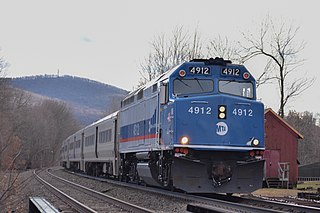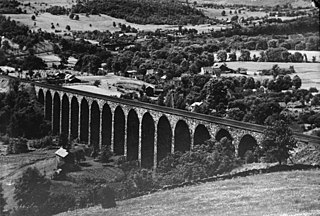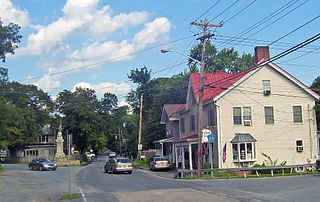
Cornwall is a town in Orange County, New York, United States, approximately 50 miles (80 km) north of New York City on the western shore of the Hudson River. As of the 2020 census, the population was at 12,884. Cornwall has become a bedroom community for area towns and cities including New York City. Commuter rail service to North Jersey and New York City is available via the Salisbury Mills–Cornwall train station, operated by NJ Transit on behalf of Metro-North Railroad. The town is located less than an hour from the George Washington Bridge with access to major commuter routes such as the New York State Thruway and the Palisades Parkway.

The Delaware, Lackawanna and Western Railroad, also known as the DL&W or Lackawanna Railroad, was a U.S. Class 1 railroad that connected Buffalo, New York, and Hoboken, New Jersey, and by ferry with New York City, a distance of 395 miles (636 km). The railroad was incorporated in Pennsylvania in 1853, and created primarily to provide a means of transport of anthracite coal from the Coal Region in Northeast Pennsylvania to large coal markets in New York City. The railroad gradually expanded both east and west, and eventually linked Buffalo with New York City.

NJ Transit Rail Operations is the rail division of NJ Transit. It operates commuter rail service in New Jersey, with most service centered on transportation to and from New York City, Hoboken, and Newark. NJ Transit also operates rail service in Orange and Rockland counties in New York under contract to Metro-North Railroad. The commuter rail lines saw 57,179,000 riders in 2023, making it the third-busiest commuter railroad in North America and the longest commuter rail system in North America by route length.

A trestle bridge is a bridge composed of a number of short spans supported by closely spaced frames. A trestle is a rigid frame used as a support, historically a tripod used to support a stool or a pair of isosceles triangles joined at their apices by a plank or beam such as the support structure for a trestle table. Each supporting frame is a bent. A trestle differs from a viaduct in that viaducts have towers that support much longer spans and typically have a higher elevation.

The Port Jervis Line is a predominantly single-track commuter rail line running between Suffern and Port Jervis, in the U.S. state of New York. At Suffern, the line continues south into New Jersey on NJ Transit's Main Line. The line is operated by NJ Transit Rail Operations under a contract with Metro-North Railroad (MNRR).

New York State Route 94 (NY 94) is a state highway entirely within Orange County in southern New York. The western terminus is at the New York–New Jersey state line, where it continues as New Jersey's Route 94 for another 46 miles (74 km) to Columbia, New Jersey. Its eastern terminus is located at U.S. Route 9W (US 9W) in New Windsor. From Warwick to Florida, NY 94 is concurrent with NY 17A. The entirety of NY 94 is known as the 94th Infantry Division Memorial Highway.

The Thomas Viaduct spans the Patapsco River and Patapsco Valley between Relay, Maryland and Elkridge, Maryland, USA. It was commissioned by the Baltimore and Ohio Railroad (B&O); built between July 4, 1833, and July 4, 1835; and named for Philip E. Thomas, the company's first president. Some claim it to be the world's oldest multiple arched stone railroad bridge. However, the Sankey Viaduct on the Liverpool and Manchester Railway was opened in 1830 and finally completed in 1833.

Starrucca Viaduct is a stone arch bridge that spans Starrucca Creek near Lanesboro, Pennsylvania, in the United States. Completed in 1848 at a cost of $320,000, it was at the time the world's largest stone railway viaduct and was thought to be the most expensive railway bridge as well. Still in use, the viaduct is listed on the National Register of Historic Places and is designated as a National Historic Civil Engineering Landmark.

Salisbury Mills–Cornwall station is a commuter rail stop owned by Metro-North Railroad serving trains on the Port Jervis Line, located in the Beaver Dam Lake section of the town of Cornwall, New York. The station is located at the northern end of the Moodna Viaduct, accessible from NY 94. Parking fees are charged on weekdays, with both permit and metered spaces available. Salisbury Mills–Cornwall station contains a large parking lot, lighting, elongated canopy and a mini high-level platform for wheelchair access to trains.

Tunkhannock Creek Viaduct is a concrete deck arch bridge on the Nicholson Cutoff rail line segment of the Norfolk Southern Railway Sunbury Line that spans Tunkhannock Creek in Nicholson, Pennsylvania. Measuring 2,375 feet (724 m) long and towering 240 feet (73.15 m) when measured from the creek bed, it was the largest concrete structure in the world when completed in 1915 and still merited "the title of largest concrete bridge in America, if not the world" 50 years later.

Salisbury Mills is a hamlet and census-designated place (CDP) in the towns of Blooming Grove and Cornwall in Orange County, New York, United States. As of the 2020 census, it had a population of 580.

The Metropolitan Subdivision is a railroad line owned and operated by CSX Transportation in the District of Columbia and the U.S. state of Maryland. The 53-mile line runs from Washington, D.C., northwest to Weverton, Maryland, along the former Metropolitan Branch of the Baltimore and Ohio Railroad.

Moodna Creek is a small tributary of the Hudson River that drains eastern Orange County, New York. At 15.5 miles (25 km) in length from its source at the confluence of Cromline Creek and Otter Kill west of Washingtonville, it is the longest stream located entirely within the county.

The Kate Shelley High Bridge, officially called the Boone Viaduct when it was completed in 1901, is one of the highest and longest double-track railroad bridges in the United States. It is located approximately 3 miles (4.8 km) west of Boone, Iowa.

The Kinzua Bridge or the Kinzua Viaduct was a railroad trestle that spanned Kinzua Creek in McKean County in the U.S. state of Pennsylvania. The bridge was 301 feet (92 m) tall and 2,052 feet (625 m) long. Most of its structure collapsed during a tornado in July 2003.

The NX Draw is an out-of-service railroad bridge on the Passaic River between Newark and Kearny, New Jersey. It is the 13th bridge from the river's mouth at Newark Bay and is 6.5 miles (10.5 km) upstream from it. The bascule bridge, built by the Erie Railroad and once part of its Newark Branch, has been abandoned in the raised position.

The Graham Line is the portion of the former Erie Railroad in New York State from Highland Mills to Guymard, constructed from 1906 to 1909 as a high-speed freight line. The Graham Line bypasses the original Erie Main Line through Monroe, Chester, Goshen and Middletown. Grade on the Graham Line was not to exceed 0.2% eastward or 0.6% westward, while the original Main Line built in the 1840s had grades up to 1.25%. There were three places where freight trains needed a helper on the old line and none on the new, but just west of the cutoff the grade up from Port Jervis to Guymard could not be improved, and remained unchanged as the only place in the area needing a helper. The sharpest curve on the old line was 7 degrees and on the new was 1 deg 30 min. The Graham Line has no grade crossings: a rarity on the Erie. The downside of the improved grade and curvature is that the Graham Line is seven miles longer than the original mainline. Maintaining the desired grade required two notable engineering features: the Moodna Viaduct and the Otisville Tunnel.

The Little Pipe Creek bridge and viaduct is a 705-foot (215 m) continuous truss bridge with a main span and 19 viaduct sections as well as an active railroad trestle crossing Little Pipe Creek south of Keymar, Maryland. Originally constructed by the Frederick and Pennsylvania Line Railroad Company (F&PL). Construction on the trestle began in late 1871 and continued until April 1872.
The Erie Railroad Newburgh Branch is a mostly abandoned branch line that travels across the center of Orange County, New York. It survives as the CSX Vails Gate Spur between Newburgh and Vails Gate, but is abandoned between Vails Gate and the end of the line in Greycourt. When it opened in 1850, it was Newburgh's first railroad and remained the only line serving the city for over three decades until the first train operated from Newburgh along the West Shore Railroad in 1883.























